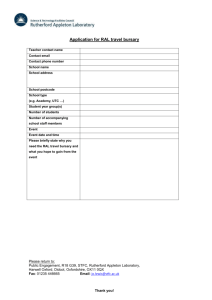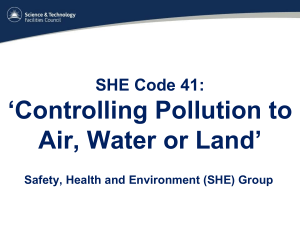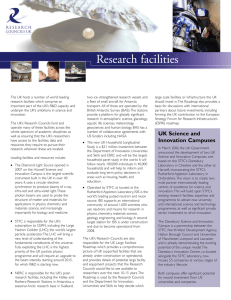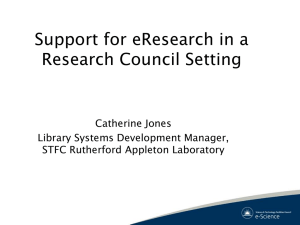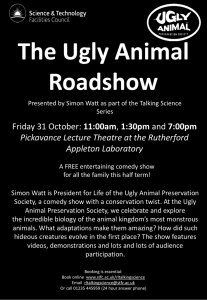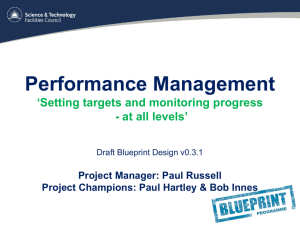STFC Newton Agri Workshop Summary
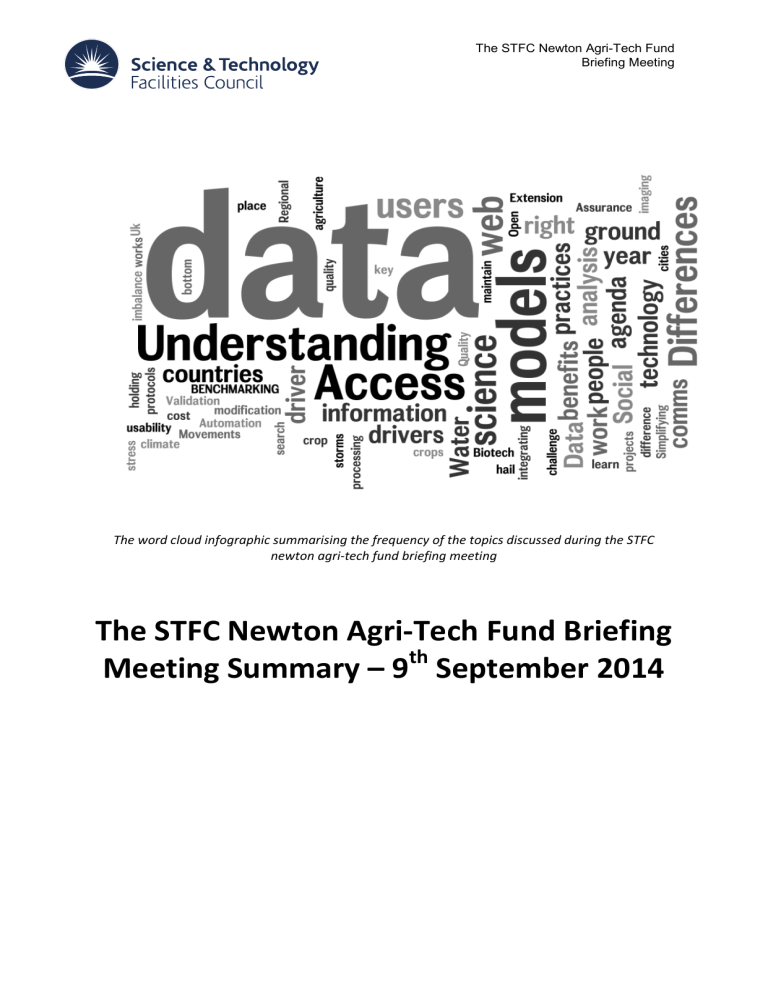
The STFC Newton Agri-Tech Fund
Briefing Meeting
The word cloud infographic summarising the frequency of the topics discussed during the STFC newton agri-tech fund briefing meeting
The STFC Newton Agri-Tech Fund Briefing
Meeting Summary – 9
th
September 2014
The STFC Newton Agri-Tech Fund
Briefing Meeting
Workshop Summary
As part of the STFC Newton Agri-Tech Fund a one day briefing meeting was held at the Rutherford
Appleton Laboratory in Harwell 9 th
September 2014. This workshop, delivered by STFC delivery partners, brought together academic and industrial researchers with key stakeholders to deliver information about the Newton Agri-Tech fund as well as to identify the key challenges associated with working on this programme.
Attended by 45 participants, the workshop was a combination of high level programme information presentations and short, targeted presentations from the key stakeholder. The session of talks was followed by a facilitated breakout discussion. Ultimately the workshop achieved the following key outcomes:
It created a forum to bring together both science providers with end-users, to allow both networking and sharing of perspectives. The inclusion of partners from industry was highly beneficial in this respect.
It was truly inter-disciplinary platform, bringing together individuals from different science disciplines (e.g. remote sensing, modelling, data providers) and fields of interest (e.g. plant health, commercial horticulture and homeland security).
It facilitated an open discussion around the subject of the research and operational challenges of working with China.
It provided information to the participants on the STFC Newton Agri-Tech Fund and provided and discussed the aims and objectives of this fund.
The workshop structure –
The workshop structure, see Annex 1 ‘Workshop Programme”, was a combination of short, targeted presentations and facilitated breakout sessions. The majority of the talks were programmatic related, focusing on the Newton fund, the proposed stakeholder engagement process and an outline objective of the 5 year fund. There was a 90 minute section dedicated to user and stakeholder introductions. This gave an opportunity for the attendees to introduce themselves and highlight how the Newton fund would be relevant to their work. This stakeholder review covered the breadth of technologies, requirements and needs that spanned academic modelling (such as talks presented by
Lisa Emberson from York university and Andy Channillor from Leeds University) modelling platform providers (Vince Gillingham, from agSpace and Stephanie Race from Crop Performance Ltd), seed and agrichemcal businesses (e.g. Les May from Syngenta) and plant health government organisations (e.g. Shaun Hobbs, CABI) and remote sensing data providers. The afternoon was dedicated to a breakout session where the participants were split into 4 groups, each lead by an experienced facilitator. The Knowledge Cafe concept was used: participants presented their ideas about one area and then the groups rotated. This allowed everyone to comment on each of the questions posed and to see and debate what other groups had discussed. At the end of the process, the main outcome from the breakout session were summarised. The breakout session focused on four areas and a problem/solution analysis was carried out to identify the key barriers and opportunities in this area in the short and longer-term.
Workshop Participants
The workshop brought together 45 individuals; see Annex 3 ‘Workshop Participants List’, representing regulators, stakeholders and researchers. This diverse group included policy makers
(e.g UKTI, Forestry Commission), data providers, stakeholders (e.g. FERA, Syngenta, CABI) and industry (e.g. agSpace, Magellium, crop perfomanceLtd. Etc.) Alongside academic researchers from
Leeds, Leicester, and York University.). These groups, research institutes and government science
The STFC Newton Agri-Tech Fund
Briefing Meeting agencies provided a huge depth and breadth of multi-disciplinary expertise; representing the biological, mathematical and physical sciences.
Outputs
The key output from the meeting were the extensive ideas and discussions captured during the breakout discussion session. The many hand-written pages generated have been typed up and while not included in this report (for reasons of space), they are available on request if required. The key points captured and prioritised are summarised here:
1. Challenges and opportunities with working with China.
Figure 1. The word cloud infographic summarising the frequency of the topics discussed during the
China breakout session
Data Security: What are the likely constraints of using/acquiring remote sensing data over
China. This is in view of looking at historical data and current/future data sets.
Intellectual Property (IP) Challenges: How will IP be protected whilst working across boarders and what are the likely methods for ensuring UK commercial interests while working on the project.
Political: What are the political constraints that will arise. Area of concern include the early identification of the correct Chinese project partners. Understanding who the beneficiaries/customers will be. Recognising the equivalent parties in China and
The STFC Newton Agri-Tech Fund
Briefing Meeting developing the relationships with them and engagement with the Chinese SME’s, NGO’s and other key stakeholders that should be involved in this programme.
Social/Economic Demographic Shifts: Understand how the shifting social and economic climate within China could impact on the projects and review how each project could be adopted in a future Chinese market scenario.
Geographical Diversity: The physical size of China means that the programme will have to deliver on projects over very large scales which span varying climates. Over these large scales there are a large range of pests, a wide variety of diseases and cover a multitude of crops. These variables should be understood and mapped to provide the programme an understanding of the “challenge landscape” that they are working in.
Existing And Historical Networks/Projects And Programmes: Learn from historical and current programmes with China. Look at the lessons learnt and build on existing networks where possible
Cultural And Language Differences. Understand and have methods to engage with a country which has cultural differences.
2. Programmatics
Figure 2. The word cloud infographic summarising the frequency of the topics discussed during the programmatics breakout session
Early Identification Of And Engagement With The Correct End Beneficiaries: These could be a diverse range of end users that include: grower/farmer/land manager or owner
The STFC Newton Agri-Tech Fund
Briefing Meeting
Identify The Key Players In China: The partners in the government, in the cooperatives and individual growers (Large or small), in industry and academia should be identified as a matter of urgency to understand the Chinese perspective on this programme.
Need To Develop A Thematic Based Programme: For maximum impact, a thematic based program should be developed. This could focus on things such as: Diseases, Pests, Crop Yield
Prediction etc.
Understand The Socio- Economic Aspects Of The Programme: Who the programme aims to target, what the aims of the programme are to be and how the impact will be measured should be outlined very early on. This includes methods to ensure affordability, routes to commercialisation and understanding the benefices of the programme.
Be Multidisciplinary: It was suggested that the programme should be highly multidisciplinary bringing together modelling and remote sensing experts with other areas such as social sciences, statisticians and experimentalists.
Early Identification Of Trade And Resource Restrictions: Understand where the differences are with UK/China working methods and practices to highlight risks and avoid programmatic problems in the future. Pesticides and weed control were used as examples.
Translation Of Projects: What are the best methods to translate the results of the program to real impact case studies. Ideas of engage TSB/UKTI from the outset were suggested.
Low Administration Burden: It was noted that to maximise impact of the projects that the administration burden should be kept to a minimum.
IP Management Plan: A method to ensure that Intellectual property is maintained should be adopted early on in the programme.
Project Group Sizes Should Be Manageable: There should be a concerted effort to balance between large consortium projects and small focus groups.
Understand And Advertise The Time Frame: This should encompass the programmatic time frames as well as the expected times to impact.
Identify The Existing Research Capability In China And The UK: What is the current state of the art in technology and modelling capabilities in the UK and in China.
3. Research
The STFC Newton Agri-Tech Fund
Briefing Meeting
Figure 3. The word cloud infographic summarising the frequency of the topics discussed during the research breakout session
The discussion produced a list of research challenges. These topics included: o Water quality o Animal health o Social science usability o Predicting hail storms o Weather modification o Matching crops to climate (Water, Heat stress, Plant breeding, Biotech) o Combing data and models (assimilation) o Data fusion o Pattern recognition. o Sentinel 2 data coming online o Big data challenge o Hyperspectral imaging o High spatial, Spectral and Temporal resolution Imaging
Understanding the market place and the potential benefits that could be returned to the UK from technology development.
The STFC Newton Agri-Tech Fund
Briefing Meeting
In addressing the research challenges it is important to understand: o What are the local resources are available to the Chinses farmer/grower e.g. mobile communications availability. o What is the skills gap in the social classes in China and between UK and China farmers. o What Is The Current State Of The Art In China: In terms of research, SME capabilities, technology, farming practices, resources, o Differences in priorities for UK and China
Understanding where the main benefits from partnering with china are for the UK
Access To Historical Remote Sensing Data In China
Validation of product, Quality Assurance, ground truthing and calibration. Differences in data archiving and data processing, Using consistent protocols
What 5 case studies do we want to be showing in 5 years
How we should be looking to translate the science to products and commercial services.
4. United Kingdom
Figure 4. The word cloud infographic summarising the frequency of the topics discussed during the
UK breakout session
A list of the areas of UK research excellence was created that included: o Research into crop varieties – maize, wheat, potato as well as the expertise in nonfood crops (feedback to UK needs) o Growing practices, and land use management and optimisation
The STFC Newton Agri-Tech Fund
Briefing Meeting o Numerical Modelling, interpretation, analysis o Climate change research o Collection and interpretation of data across the electromagnetic spectrum from Lidar, radar data, thermal UV and spectral. o Cross-disciplinary research base (including social / behavioural science) o Data assimilation with models o Data fusion o The development of detectors and sensors o Weather and seasonal forecasting o Autonomous robotics o Interaction of farming practices with flood risk modelling and management o Practical applications of HPC including provision of access
The UK has significant strengths in the coordination and management of large scale international programmes
The UK has a recognised international scientific reputation based on excellence and high impact publications
The UK is a world leader in Insurance products and financial services
The UK has strengths in the business innovations sector: Translating scientific technology and knowledge into commercial products and services
The STFC Newton Agri-Tech Fund
Briefing Meeting
Annex 1: Workshop Programme
10:00 Registration and Coffee
10:30 Introduction and welcome - Richard Holdaway
10:50 Programme overview and focus - Hugh Mortimer/Andy Shaw
11:10 2-minute stakeholder profiles - All
12:30 Lunch and Networking
13:30 Introduction to Network Plus - Katharine Hollinshead
13:50 Agri-Tech issues and Challenges - Geoff McBride
14:10 Coffee Break
14:30 Breakout Session – Problems, Gaps/Barriers and Solutions - All
15:30 Summary, way forward and wrap up
16:00 End
The STFC Newton Agri-Tech Fund
Briefing Meeting
Annex 2: Discussion Groups
The key drivers for stakeholders (problems and solutions) – for regulators, industry, NGOs
Group Subject Facilitator
3
4
1
2
China
Programmatics
Research
UK
Hugh Mortimer
Andy Shaw
Geoff McBride
Jon Styles
Annex 3: Workshop Participants List
Name
Peter Allan
Samuel Almond
Giles Barker
Tim Beale
Clive
Philip
Blacker
Briscoe
Andrew Burrows
Andy
Allister
Challinor
Clarke
Company
STFC - RAL Space
CGI giles@kisanhub.com
CABI
UK Trade and Investment
Rezatec
B3 Agri-tech
University of Leeds
AC Synergy
Email peter.allan@stfc.ac.uk sam.almond@cgi.com giles@kisanhub.com t.beale@cabi.org
Clive.Blacker@UKTI-INVEST.COM philip.briscoe@rezatec.com burrows.r.andrew@gmail.com
A.J.Challinor@leeds.ac.uk allister@ac-synergy.com
Andrew Crowe
Lisa Emberson
FERA
SEI York, Env.Dept., UoYork
Daniel Gandolfo STFC - RAL Space
Vincent Gillingham AgSpace
Gomez-
Jose Dans NCEO & UCL
Simon Griffin SOYL andrew.crowe@fera.gsi.gov.uk l.emberson@york.ac.uk daniel.gandolfo@stfc.ac.uk vince.gillingham@ag-space.com j.gomez-dans@ucl.ac.uk simong@soyl.co.uk
Mark
Shaun
Hampson
Hobbs
Satellite Applications Catapult
CABI
Richard Holdaway STFC - RAL Space
Mark.hampson@sa.catapult.org.uk s.hobbs@cabi.org richard.holdaway@stfc.ac.uk
Katharine Hollinshead STFC
Alistair House A&R House
Steve Keyworth Ursula Agriculture katharine.hollinshead@stfc.ac.uk alistair@purnhousefarm.co.uk steve.keyworth@ursula-ag.com
The STFC Newton Agri-Tech Fund
Briefing Meeting
Aron Kisdi STFC - RAL Space
Michael Lawrence Magellium Limited
Zhenhong Li Newcastle University
Hugh Loxton W.H.Loxton Limited
Ben
Terry
Leslie
Kevin
Alice
Hugh
Marchant
Mawby
May
Middleton
Milne
Mortimer
David Moss
Booker Ogutu
British Geological Survey
STFC
Syngenta
STFC - RAL Space
Rothamsted Research
STFC - RAL Space
STFC
University of Leicester aron.kisdi@stfc.ac.uk michael.lawrence@magellium.co.uk zhenhong.li@newcastle.ac.uk hugh@whloxton.co.uk benmarch@bgs.ac.uk terry.mawby@stfc.ac.uk leslie.may@syngenta.com kevin.middleton@stfc.ac.uk alice.milne@rothamsted.ac.uk hugh.mortimer@stfc.ac.uk david.moss@stfc.ac.uk boo7@leicester.ac.uk
Stephanie Race
Abigail Rumsey
Andy Shaw
Sheena Shields
Kevin Smith
Julian Smith
Crop Performance Ltd.
CABI srace@crop-performance.com a.rumsey@cabi.org
Terreflexion Consulting Limited terreflexion@btinternet.com
Newcastle University
STFC
FERA sheena.shields@ncl.ac.uk kevin.smith@stfc.ac.uk julian.smith@fera.gsi.gov.uk
Vladimir Stoiljkovic Satellite Applications Catapult vladimir.stoiljkovic@sa.catapult.org.uk
Jon Styles Assimila Ltd jon.styles@assimila.eu
Juan Suarez Forest Research, UK Juan.Suarez@forestry.gsi.gov.uk
Srini
Wayne
Sundaram Agrisolum
Tubby STFC - RAL Space srini.sundaram@agrisolum.com wayne.tubby@stfc.ac.uk
